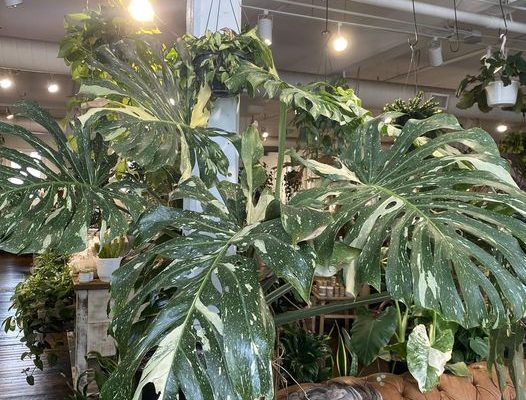Maintain high humidity levels using a pebble tray or a humidifier.
Windowleaf does well in loose, airy, well-draining, fertile soil rich in loam and organic matter (peat moss).
It also grows well in heavy clay soils with neutral or acid pH levels or light sandy, medium loamy soils.
Plant Tarovine between 6′ and 12′ feet apart outdoors to allow room for growth. Ensure to push the plant’s aerial roots to absorb the nutrients more.
Repotting Monstera deliciosa in the container is best done early in the springtime. Just ensure there are adequate drainage holes so the excess water will flow out.
Grooming And Maintenance
Monstera deliciosa’s large leaves can make the plant top-heavy. Be sure to provide support using plant ties, a moss pole, or stakes to prevent toppling and breakage.
As vining plants, you can also trail your Monstera over the pot and climb along a trellis.
These plants appreciate daily misting. Wipe the leaves with a damp cloth weekly to remove dust and facilitate good photosynthesis.
Prune as needed to remove dead or damaged leaves and stems. Perform a fairly thorough pruning in the springtime. Keep healthy stems for propagation.
How To Propagate Swiss Cheese Plant
The easiest way to propagate this plant is to take cuttings and start them in water, just like a philodendron cutting.
If you wish, you can start a long cutting in soil by laying a foot-long length of vine on the surface of moist, prepared soil.
Simply press it into the soil gently so the cutting is firmly in place, but the top is still exposed to air.
It is also possible to propagate Split-leaf Philodendron through air layering. To do this, locate a leaf node and aerial root on a stem. Cover this area with a bit of dampened sphagnum moss.
Cover the moss with a bit of plastic wrap. Poke a couple of holes in the plastic wrap for air circulation.
Roots should begin to appear within a month or so. When they do, you can carefully prune the limb away from the parent plant and transfer it to its own pot.
Monstera Deliciosa Main Pest Or Diseases
For the most part, a healthy Swiss Cheese Plant is pest and disease resistant.
Be sure to provide plenty of warmth, bright, indirect sunlight, and a regular soak and dry watering schedule to help your plant ward off typical houseplant problems, such as root rot, fungal growth, and common pests like mealybugs, aphids, scale insects, spider mites, and the like.
For severe pest infestation, you can apply insecticidal soap or neem oil.

Is The Plant Considered Toxic Or Poisonous To People, Kids, And Pets?
The plant’s leaves, stems, and roots can be toxic if eaten in large quantities.
The calcium oxalate crystals they contain can cause drooling, trouble swallowing, mouth irritation, tongue and throat irritation, and vomiting.
The fruit is edible and tasty; however, it should only be eaten when ripe. It is also important to note that it is an allergen for some people.
Monstera deliciosa sap can irritate your skin. Be sure to wear gloves and eye protection when pruning this plant. Wash up afterward.
Is The Plant Considered Invasive?
Hurricane Plant is a fast-growing, enthusiastic tropical plant that is winter hardy in the tropical United States, Hawaii, and other tropical and semi-tropical settings.
Naturally, when planted outdoors in these settings, it happily spreads. Because of this, it is deemed a highly invasive risk species in tropical settings.
Suggested Split-leaf Philodendron Uses
With its easy-growing tendencies and dramatically attractive good looks, Split-leaf Philodendron is a great addition to any home or office setting. It does very well in any situation that provides it with consistent warmth and bright, indirect light (or all-day-long fluorescent light).
Feng Shui aficionados recommend it as an entryway plant because it brings happiness, luck, and wealth to the home and all who dwell there.
Like most large, leafy plants, Cutleaf Philodendron has a good reputation for improving air quality, removing odors and dust, and improving household humidity levels.
In the spring and summertime, Monstera deliciosa makes a nice container plant on porches or sheltered patio settings.
If you live in an area where it can be grown in the landscape year-round, place it in a location where it will be sheltered from high winds and harsh, noonday sun.
Place it near a stump or fence where it can climb, but avoid placing it near a building because it will cause damage.




